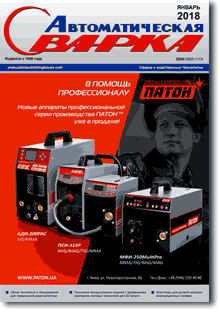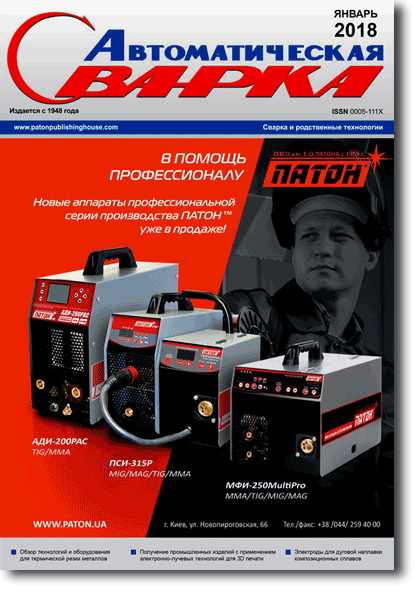| 2018 №01 (05) |
DOI of Article 10.15407/as2018.01.06 |
2018 №01 (07) |

Avtomaticheskaya Svarka (Automatic Welding), #1, 2018, pp. 40-43
Electrodes for arc hardfacing of composite alloys
A.I. Bely, A.P. Zhudra, V.I. Dzykovich and V.V. Petrov
E.O. Paton Electric Welding Institute of the NAS of Ukraine 11 Kazimir Malevich Str., 03150, Kyiv, Ukraine. E-mail: office@paton.kiev.ua
Abstract
This paper considers the peculiarities of formation of composite alloys based on tungsten carbides in arc hardfacing. It was found that application of spherical granules of tungsten carbides as a wear-resistant phase, which are to lower degree subjected to solution in process of hardfacing, is the most reasonable in development of electrode material. The optimum content of reinforcing phase in electrode metal was determined which should vary in 60–70 % limits of material weight in volume. Developed were gas-slag-forming and alloying systems and experimental compositions of the electrodes were manufactured. A series of technological peculiarities for providing coating homogeneity, consisting of components different in specific weight and granulometric composition, as well as its deposition on the electrode rod, were specified in experimental way. Determined were specifics of hardfacing process using developed electrodes, presented are the results of metallographic examinations of the deposited metal. Laboratory abrasive wear tests of composite alloys with experimental electrodes showed their high efficiency. 10 Ref., 1 Table, 2 Figures.
Keywords: arc hardfacing, composite alloy, coated electrode, tungsten carbide, reinforcing particles, wear resistance
Received: 28.11.17
Published: 15.02.18
References
- Zhudra, A.P. (2014) Tungsten carbide based cladding materials. The Paton Welding J., 6–7, 66–71. https://doi.org/10.15407/tpwj2014.06.13
- (2016) Weld hardface and cladding material guide. Oerlikon Metco, 8.
- (2016) Hard-facing materials. DURUM Verschleiss-Schutz GmbH.
- Harper, D., Gill, M., Hart. K.W.D., Anderson, M. (2002) Plasma transferred arc overlays reduce operating costs in oil sand processing. In: of Int. Thermal Spray Conf. (March 4–6, 2002, Essen, Germany). ASM International, 278–293.
- Som, A.I. (2004) Plasma-powder surfacing of composite alloys based on cast tungsten carbides. The Paton Welding J., 10, 43–47.
- Bely, A.I. (2010) Influence of main technological parameters of the plasma cladding process on properties of composite deposited metal. Ibid., 6, 25–27.
- Danilov, L.I., Rovenskykh, F.M. (1973) Surfacing of parts of charging equipment of blast furnace by composite alloy. Metallurg, 1, 18–21 [in Russian].
- Frumin, E.I., Zhudra, A.P., Pashchenko, M.A. (1979) Physico-chemical processes in surfacing by strip relite. Proizvodstvo, 10, 27–32 [in Russian].
- Zhudra, A.P., Makhnenko, V.I., Pashchenko, M.A. et al. (1975) Peculiarities of automatic arc surfacing of composite alloys. Svarka, 8, 16–19 [in Russian].
- Dzykovich, V.I., Zhudra, A.P., Bely, A.I. (2010) Properties of tungsten carbide powders produced by different technologies. The Paton Welding J., 4, 22–24.
The cost of subscription/purchase order journals or individual articles
| Journal/Currency | Annual Set | 1 issue printed |
1 issue |
one article |
| TPWJ/USD | 384 $ | 32 $ | 26 $ | 13 $ |
| TPWJ/EUR | 348 € | 29 € | 24 € | 12 € |
| TPWJ/UAH | 7200 UAH | 600 UAH | 600 UAH | 280 UAH |
| AS/UAH | 1800 UAH | 300 UAH | 300 UAH | 150 UAH |
| AS/USD | 192 $ | 32 $ | 26 $ | 13 $ |
| AS/EUR | 180 € | 30 € | 25 € | 12 € |
| SEM/UAH | 1200 UAH | 300 UAH | 300 UAH | 150 UAH |
| SEM/USD | 128 $ | 32 $ | 26 $ | 13 $ |
| SEM/EUR | 120 € | 30 € | 25 € | 12 € |
| TDNK/UAH | 1200 UAH | 300 UAH | 300 UAH | 150 UAH |
| TDNK/USD | 128 $ | 32 $ | 26 $ | 13 $ |
| TDNK/EUR | 120 € | 30 € | 25 € | 15 € |
AS = «Automatic Welding» - 6 issues per year;
TPWJ = «PATON WELDING JOURNAL» - 12 issues per year;
SEM = «Electrometallurgy Today» - 4 issues per year;
TDNK = «Technical Diagnostics and Non-Destructive Testing» - 4 issues per year.





